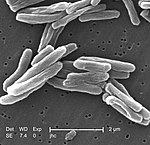Auramine phenol stain
Appearance
Auramine phenol stain is a stain used in clinical microbiology and histology to identify tuberculosis mycobacteria.
There are two types of auramine phenol stains, 1 and 2 to stain mycobacterium species and cryptosporidium respectively. Both are fluorescent stains. The bacteria or the parasites appear brilliant greenish yellow against dark background.[1] Mycolic acids of the mycobacteria keep this stain when decolorising with the acid alcohol. The method is more rapid and sensitive than ZN technique.[2]
Method
[edit]- Smears are prepared just like that for ZN staining
- Stain with Auramine-Phenol for 20 mins
- Rinse with water
- Decolourise in acid alcohol
- Rinse with water
- Counterstain with 0.1% potassium permanganate for 30 seconds
- Rinse and air dry[3]
References
[edit]- ^ "Microbiology training log". Retrieved 19 November 2012.
- ^ "Comparison of the value of two different sputum staining for diagnosis of acid-fast bacilli". Retrieved 19 November 2012.
- ^ "Parasitology stains". Archived from the original on 10 April 2011. Retrieved 19 November 2012.

